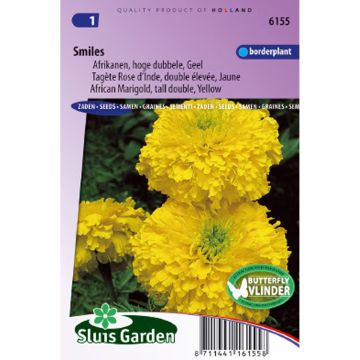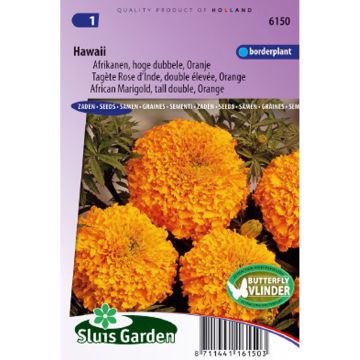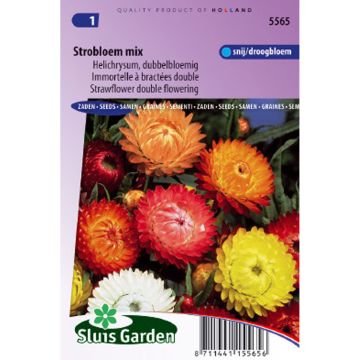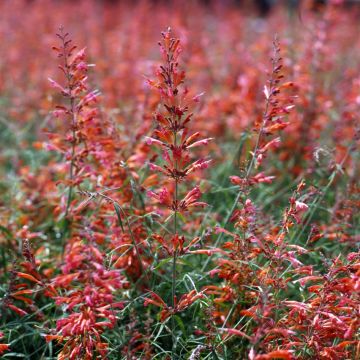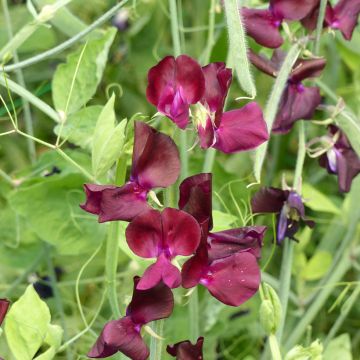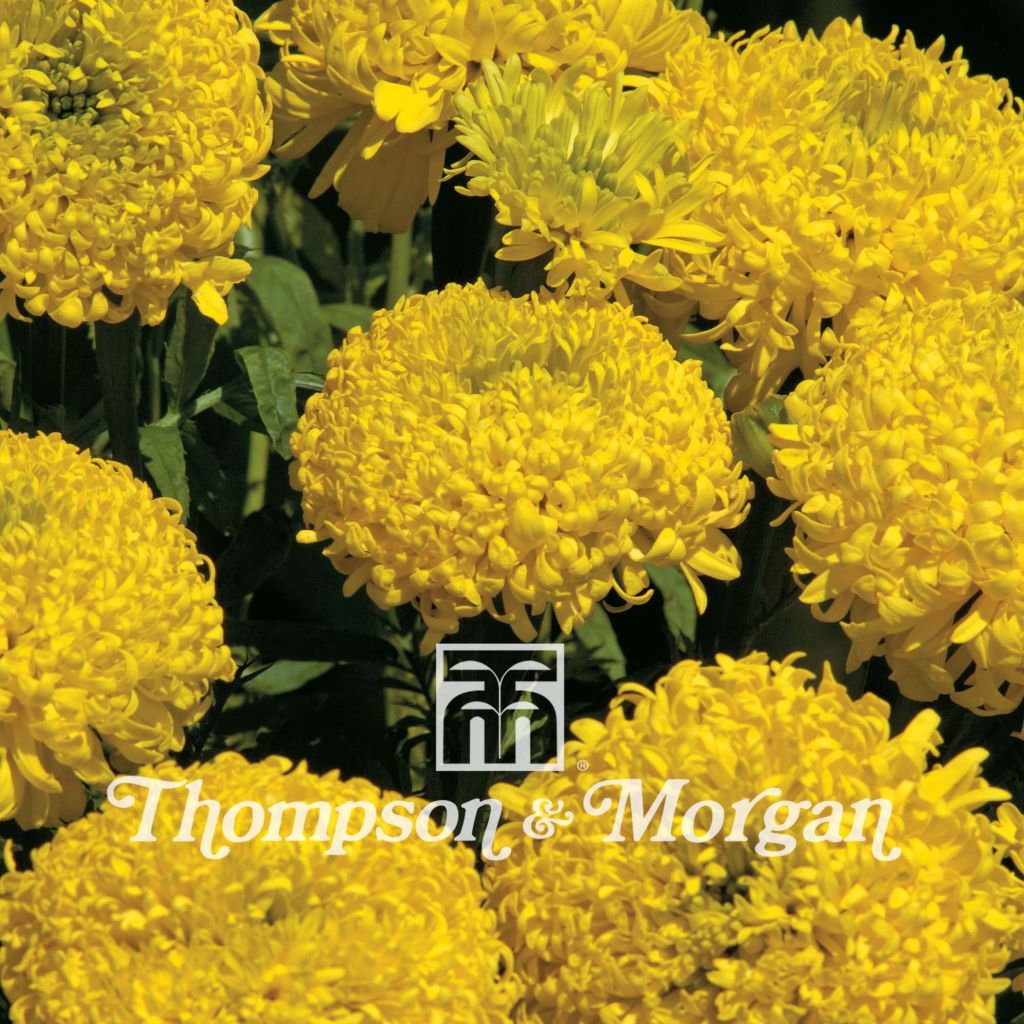

Tagetes erecta Lemon Mum Seeds - Marigold
Tagetes erecta Lemon Mum Seeds - Marigold
Tagetes erecta Lemon Mum
African Marigold, Aztec Marigold, American Marigold
Why not try an alternative variety in stock?
View all →This plant carries a 6 months recovery warranty
More information
We guarantee the quality of our plants for a full growing cycle, and will replace at our expense any plant that fails to recover under normal climatic and planting conditions.
Seed-only orders are dispatched by sealed envelope. The delivery charge for seed-only orders is €3.90.
Does this plant fit my garden?
Set up your Plantfit profile →
Description
Tagetes erecta Lemon Mum is a particularly heavy blooming and cheerful variety of Marigold or African Marigold, whose large, lemon-yellow, pompom-like flowers brighten up the garden or terrace from summer until the first frosts. These very double inflorescences are as curly as the Chrysanthemums sold on All Saints' Day and stand out beautifully against its pretty olive green foliage. This vigorous variety combines well with brighter or softer-coloured blooms in window boxes, borders and flower beds.
Tagetes erecta, better known as Marigold or African Marigold, is a plant of the family Asteraceae, native to Mexico, Central America and Western South America. This species of tender perennial has given rise to many varieties and hybrids, including 'Lemon Mum', a recent variety bred by the English seed company Thompson & Morgan. Within a few months' time, this annual plant forms vigorous bushy clumps measuring 65-75 cm high and 40-45 cm wide. Its branched stems are covered with deeply cut, pinnate, dark olive green foliage, which carries a distinct, slightly acrid fragrance, which can even be considered as unpleasant. It is a remarkably generous and long-flowering bloomer : its yellow, slightly twisted flowers are grouped into very double, globular, slightly flattened pseudanthia that measure 8-10 cm in diameter. The centre of the inflorescences are coloured yellow-green.
Marigolds are excellent summer bed plants. Although some may dislike them for their garish colours, their pungent scent or their excessively neat appearance, their truly accommodating nature and their incredible cheerfulness must not be so easily put aside. The abundant blooms and long-flowering period of the 'Lemon Mum' variety allow for an infinite number of combinations in summer and autumn beds. It can be easily be combined with blue, purple, violet, pink or red asters and sage, or with annual poppies, producing scenes that never lack in taste. They also perform very well in pots, making it possible to decorate the terrace or balcony in a very short time.
The smell of the marigold's foliage and the substances secreted by their roots repel certain insects that are harmful to crops, which is why these plants are often planted between vegetables in the garden. A food colouring called zeaxanthin or E151h, a natural pigment safe for human consumption, is extracted from the marigold.
Report an error about the product description
Flowering
Foliage
Plant habit
Botanical data
Tagetes
erecta
Lemon Mum
Asteraceae
African Marigold, Aztec Marigold, American Marigold
Cultivar or hybrid
Other African Marigold seeds
Planting and care
Sowing:
Sow from February to April.
Sow on the surface of a moist, well-drained seed starting mix. Cover the seeds with a very thin layer of vermiculite or potting soil. Place the seedlings in a mini greenhouse or seal them within a transparent plastic bag and keep at a constant temperature of 20 to 25° until germination, which usually takes 7 to 21 days. Do not deprive the seedlings of light, as this helps germination.
When the young plants are large enough to be handled, transplant them into a tray or 8 cm pots. Acclimatize to cooler conditions for 10-15 days before planting out, 15-20 cm apart and as soon as frost is no longer a concern.
Cultivation:
These fast-growing plants thrive in sunny, warm conditions. Place them in fertile, well-drained, light soil. Avoid over-watering in summer, as this encourages the development of fungal diseases and root rot. Regularly remove wilted flowers to prolong flowering. Protect the plants from slugs and snails that are fond of them. Tagetes tenuifolia does not tolerate frost.
Sowing period
Intended location
This item has not been reviewed yet - be the first to leave a review about it.
Flower seeds
Haven't found what you were looking for?
Hardiness is the lowest winter temperature a plant can endure without suffering serious damage or even dying. However, hardiness is affected by location (a sheltered area, such as a patio), protection (winter cover) and soil type (hardiness is improved by well-drained soil).

Photo Sharing Terms & Conditions
In order to encourage gardeners to interact and share their experiences, Promesse de fleurs offers various media enabling content to be uploaded onto its Site - in particular via the ‘Photo sharing’ module.
The User agrees to refrain from:
- Posting any content that is illegal, prejudicial, insulting, racist, inciteful to hatred, revisionist, contrary to public decency, that infringes on privacy or on the privacy rights of third parties, in particular the publicity rights of persons and goods, intellectual property rights, or the right to privacy.
- Submitting content on behalf of a third party;
- Impersonate the identity of a third party and/or publish any personal information about a third party;
In general, the User undertakes to refrain from any unethical behaviour.
All Content (in particular text, comments, files, images, photos, videos, creative works, etc.), which may be subject to property or intellectual property rights, image or other private rights, shall remain the property of the User, subject to the limited rights granted by the terms of the licence granted by Promesse de fleurs as stated below. Users are at liberty to publish or not to publish such Content on the Site, notably via the ‘Photo Sharing’ facility, and accept that this Content shall be made public and freely accessible, notably on the Internet.
Users further acknowledge, undertake to have ,and guarantee that they hold all necessary rights and permissions to publish such material on the Site, in particular with regard to the legislation in force pertaining to any privacy, property, intellectual property, image, or contractual rights, or rights of any other nature. By publishing such Content on the Site, Users acknowledge accepting full liability as publishers of the Content within the meaning of the law, and grant Promesse de fleurs, free of charge, an inclusive, worldwide licence for the said Content for the entire duration of its publication, including all reproduction, representation, up/downloading, displaying, performing, transmission, and storage rights.
Users also grant permission for their name to be linked to the Content and accept that this link may not always be made available.
By engaging in posting material, Users consent to their Content becoming automatically accessible on the Internet, in particular on other sites and/or blogs and/or web pages of the Promesse de fleurs site, including in particular social pages and the Promesse de fleurs catalogue.
Users may secure the removal of entrusted content free of charge by issuing a simple request via our contact form.
The flowering period indicated on our website applies to countries and regions located in USDA zone 8 (France, the United Kingdom, Ireland, the Netherlands, etc.)
It will vary according to where you live:
- In zones 9 to 10 (Italy, Spain, Greece, etc.), flowering will occur about 2 to 4 weeks earlier.
- In zones 6 to 7 (Germany, Poland, Slovenia, and lower mountainous regions), flowering will be delayed by 2 to 3 weeks.
- In zone 5 (Central Europe, Scandinavia), blooming will be delayed by 3 to 5 weeks.
In temperate climates, pruning of spring-flowering shrubs (forsythia, spireas, etc.) should be done just after flowering.
Pruning of summer-flowering shrubs (Indian Lilac, Perovskia, etc.) can be done in winter or spring.
In cold regions as well as with frost-sensitive plants, avoid pruning too early when severe frosts may still occur.
The planting period indicated on our website applies to countries and regions located in USDA zone 8 (France, United Kingdom, Ireland, Netherlands).
It will vary according to where you live:
- In Mediterranean zones (Marseille, Madrid, Milan, etc.), autumn and winter are the best planting periods.
- In continental zones (Strasbourg, Munich, Vienna, etc.), delay planting by 2 to 3 weeks in spring and bring it forward by 2 to 4 weeks in autumn.
- In mountainous regions (the Alps, Pyrenees, Carpathians, etc.), it is best to plant in late spring (May-June) or late summer (August-September).
The harvesting period indicated on our website applies to countries and regions in USDA zone 8 (France, England, Ireland, the Netherlands).
In colder areas (Scandinavia, Poland, Austria...) fruit and vegetable harvests are likely to be delayed by 3-4 weeks.
In warmer areas (Italy, Spain, Greece, etc.), harvesting will probably take place earlier, depending on weather conditions.
The sowing periods indicated on our website apply to countries and regions within USDA Zone 8 (France, UK, Ireland, Netherlands).
In colder areas (Scandinavia, Poland, Austria...), delay any outdoor sowing by 3-4 weeks, or sow under glass.
In warmer climes (Italy, Spain, Greece, etc.), bring outdoor sowing forward by a few weeks.



































